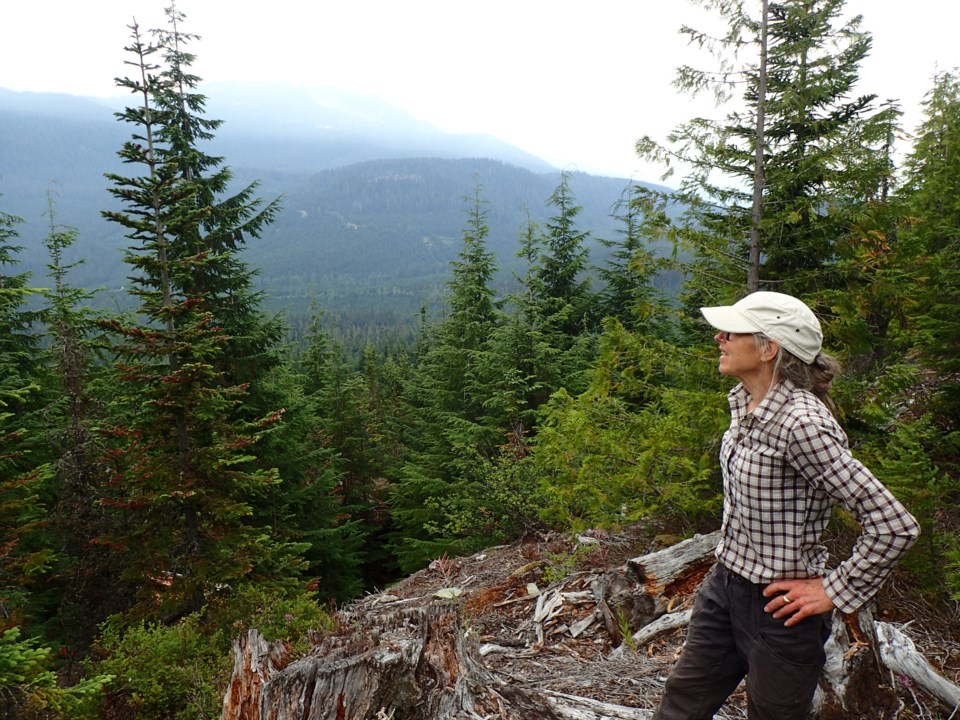The Cheakamus Community Forest (CCF) will test green fuel breaks as part of an upcoming pilot study, a recommendation from a Whistler ecologist who has lobbied the municipality for years to rethink its approach to mitigating wildfire.
Rhonda Millikin has long argued against fuel-thinning and other FireSmart practices, believing the approach not only isn’t effective in Whistler’s wet, coastal rainforest, but is actually adding to the community's fire risk. She has instead advocated for rainwater catchments, sprinkler systems, and natural green fuel breaks. Last summer, she presented the findings of a self-funded study to Whistler’s mayor and council that analyzed the effectiveness of her recommended approach and, in November, presented a petition signed by nearly 200 people calling on the Resort Municipality of Whistler (RMOW) to complete a pilot program testing her approach in two local neighbourhoods.
In an email, CCF executive director Heather Beresford confirmed the publicly managed forest would test out green fuel breaks on its tenure, although she noted the pilot was still in the planning stages.
“The CCF is committed to working with Rhonda to see how we can answer the questions she's raised through her research. We want to do a test pilot but I'm not sure we can commit to this year,” Beresford wrote. “There hasn't been any planning yet to identify a location or secure seedlings, permits, etc.”
It is arguably the biggest breakthrough yet for the retired ecologist, whose research has been met with mixed reactions, including from the RMOW, which co-manages the CCF alongside the Lil’wat and Squamish First Nations. While Millikin’s volunteer contributions to the Forest and Wildland Advisory Committee were recognized by the RMOW in 2021 with a Civic Service Award, the municipality has stopped short of adopting her wildfire strategy whole cloth, citing the differing science.
Forester Bruce Blackwell, who helped author Whistler’s wildfire strategy, has also criticized Millikin’s research, arguing her preferred approach would have little impact on fighting a large-scale, out-of-control wildfire.
“You have got to speak to how you’re changing the fire intensity when you’re removing the fuel. Everything is going to dry out in 90th percentile weather conditions. Everything. In the kind of scenario we’re trying to protect Whistler against, everything is dry and everything is going to burn,” he said.
“From my perspective, a lot of mitigation work has to be done to protect this community. I’m afraid this dialogue will set back that mitigation and really jeopardizes the community. It compromises safety.”
In response, Millikin questioned how the professional forester would know if her approach would be effective if it hasn’t been tested locally.
“Without any data, we cannot say it won’t work. My question has been, since 2020, why do we not collect data to determine if there is a better approach? We need to look at this," she said. “The published paper in the International Fire Journal with a fire scientist showed that the current approach is making things worse. If we know that, we need to find another way.”
Millikin’s advocacy led to Forestry Professionals British Columbia (FPBC) issuing her a cease-and-desist in December, following a complaint that was lodged to the non-profit tasked with regulating B.C.’s professional foresters. In his Dec. 14 letter, Casey Macaulay, the FPBC’s registrar and director of act compliance, wrote Millikin was unlawfully engaged in the reserved practice of professional forestry by providing advice and recommendations to the RMOW to limit or cease fuel-thinning. The FPBC also lodged a formal complaint with B.C.’s College of Applied Biologists, to which Millikin belongs. A spokesperson for the college confirmed it had received the complaint but declined to comment further.
That prompted Phil Burton, professor of ecosystem science and management at the University of Northern B.C., to send an email to his ecology colleagues decrying the FPBC’s “heavy-handed” response to Millikin’s work.
“These sorts of responses had been typically issued decades ago when registered professional foresters had the exclusive jurisdiction over land-management decisions, especially on Crown land in B.C. More recently, they recognized the value of many other allied professionals, such as professional biologists, agrologists, and so forth. There is a lot of overlap when it comes to recommended best practices in any kind of ecosystem management situation,” he said in a follow-up interview. “I don’t think foresters have the best knowledge when it comes to the best approach to reducing the risk of fire.”
Burton, who has conducted his own fuel moisture monitoring in B.C.’s Northern Interior, doesn’t entirely agree with elements of Millikin’s research—namely, that Whistler should cease fuel-thinning completely—but still believes there is room to test her approach.
“I just think we should have more side-by-side comparisons of approaches,” he said. “Some of my own research suggests we don’t understand everything we need to about what stops fire.”
Millikin remains hopeful to engage private homeowners in a pilot study testing rainwater catchments and sprinkler systems in two Whistler neighbourhoods. Anyone interested in participating can contact Millikin at [email protected].






